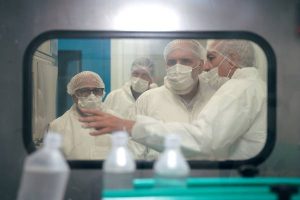
Health literacy in Iran: A vital necessity overcoming challenges
Barekat Health & Pharmaceutical Group: Health literacy is a complex, multifaceted issue that is heavily influenced by social, economic, and cultural factors. It plays a crucial role in improving public health, preventing diseases, managing treatments, and enhancing the quality of life for individuals in modern societies. This competence involves access to, understanding, evaluating, and utilizing health-related information effectively.
Health Literacy: A Pillar of Public Health
Health literacy is one of the fundamental pillars of public health in modern societies. It is essential for the prevention of diseases, management of treatments, and overall improvement in individuals’ well-being. Health literacy not only refers to an individual’s ability to access and understand medical information, but it also involves making informed decisions about health practices, the prevention of diseases, and seeking appropriate medical treatment when necessary.
In Iran, despite significant advancements in medical science and public health, the overall health literacy level remains below expectations for a substantial portion of the population. This issue contributes to a higher disease burden and significantly increases healthcare costs.
Health Literacy in Iran
Research indicates that nearly half of the Iranian population lacks adequate health literacy, with this gap being more critical in rural and underprivileged areas. A lack of awareness about fundamental health issues such as proper nutrition, disease prevention, and the effective use of healthcare services represents a key challenge. Many individuals are unaware of how to assess health-related information or how to apply it to improve their health status.
Impact of Low Health Literacy on Society
The consequences of low health literacy are far-reaching. Firstly, individuals often fail to seek medical help at the early stages of illnesses due to ignorance, leading to disease progression and higher treatment costs.
Secondly, the misuse of healthcare services, including improper or excessive medication consumption, presents additional challenges to the healthcare system. Furthermore, chronic non-communicable diseases such as diabetes and hypertension, which require long-term management, are often poorly controlled due to a lack of awareness.
Additionally, the absence of adequate health education in the school system and media exacerbates the situation. In many regions, particularly in rural and underprivileged areas, people do not have access to correct and reliable health information.
The insufficient emphasis on health education in schools and social institutions has led to many individuals being unable to make informed decisions about maintaining the health of themselves and their families. This leads to problems such as improper medication use, failure to follow proper diets, and neglect of medical treatments, all of which can contribute to the spread of diseases and escalate healthcare costs.
Social Dimensions of Health Literacy
Health literacy is closely related to the social quality of life. In societies with low health literacy, risky behaviors and neglect of disease prevention are more prevalent. Many diseases, particularly chronic non-communicable diseases like diabetes and hypertension, require ongoing care and management. Low health literacy can therefore lead to an increase in the number of patients, subsequently increasing the social and economic costs for the community.
Moreover, social inequalities have exacerbated the problem. Low-income and marginalized groups, especially in rural and urban areas with low education levels, often lack proper access to healthcare services. These inequalities contribute to stark differences in the availability of health information, access to medical services, and even life expectancy.
Economic Implications of Health Literacy
Health literacy is directly linked to the economic well-being of nations. Insufficient health awareness can result in economically detrimental behaviors. For instance, delayed medical consultations, self-prescribing medications, or failure to follow healthy dietary habits can lead to more complex health issues, thus increasing healthcare costs. In some cases, these challenges lead to long-term treatments and the use of expensive medications, placing a heavy burden on the healthcare system.
Furthermore, a lower level of health literacy can negatively impact productivity and economic output. Individuals who are healthier and better able to make informed health decisions can engage more effectively in economic activities and contribute more significantly to the national economy.
Cultural Dimensions of Health Literacy
Health literacy is influenced by the cultural and social beliefs prevalent in different communities. In certain areas of Iran, particularly in rural regions, cultural and religious beliefs may hinder the acceptance of new health information or the proper use of modern healthcare services. These beliefs may include a preference for traditional treatments and a lack of trust in modern medicine.
Engaging local and indigenous cultures in disseminating health information can be an effective tool for improving health literacy in these regions. For example, utilizing community leaders or respected individuals in neighborhoods and social groups to disseminate information on disease prevention and promote healthy behaviors can significantly impact the acceptance of health changes at the community level. Establishing and expanding primary care centers in rural and underserved areas can serve as a fundamental step in improving health literacy. These centers should not only provide healthcare services but also integrate health education into their services.
Role of Media & Public Education
Media, especially television, radio, and social media platforms, can play a significant role in advancing health literacy. The production and dissemination of educational and informational content on various health issues are crucial, especially during public health crises such as pandemics or outbreaks of specific diseases.
Media outlets can raise public awareness about the importance of adhering to health guidelines and prevent the spread of misinformation and rumors. Public health campaigns can promote healthy lifestyles and prevent harmful behaviors, contributing to the overall health improvement of the community.
Intersectoral Collaborations
Improving health literacy is a national responsibility and must be addressed through intersectoral cooperation. In addition to the Ministry of Health, other sectors, such as the Ministry of Education, media, universities, non-governmental organizations, and even the private sector, must work together. For example, collaboration with the Ministry of Education could lead to the development of targeted health education programs for students, fostering awareness from a young age. Additionally, partnerships with NGOs and civil society organizations can greatly help promote health literacy in rural and underserved communities, thereby reducing disparities in healthcare access.
Technology in Enhancing Health Literacy
In today’s world, information technology plays a crucial role in enhancing health literacy. Utilizing health apps, educational websites, and social media platforms to disseminate health information can quickly help individuals make better health decisions. For example, mobile apps can assist individuals in taking their medications correctly or visiting healthcare providers at the right time. Furthermore, social media can serve as a platform for the exchange of information between individuals, healthcare professionals, and health organizations.
Global Successful Health Literacy Programs
Countries around the world have made considerable efforts in recent years to improve health literacy. Programs like the “Health Literacy Project” in Scandinavian countries, which use various media platforms to widely disseminate health information, could serve as a valuable model for other nations. Similarly, advanced countries have successfully improved health literacy among different age and social groups through the use of modern technologies, health apps, and online platforms. These initiatives include online training in disease prevention, proper medication use, and medical care.
Conclusion
Health literacy is an essential element of any country’s healthcare system, with profound effects on both individual and societal health. It encompasses not only the ability to access health information and use it effectively but also the more complex processes of evaluating information, diagnosing health issues, and making informed health decisions.
In other words, health literacy is a fundamental requirement for improving the quality of life and reducing healthcare costs in various societies. In Iran, despite the existing challenges, improving health literacy is achievable. However, this requires intersectoral cooperation and the use of all available resources, including the media, the education system, technology, and social participation. By implementing these strategies, Iran can effectively raise the level of health literacy and significantly improve the public health of the nation.
-
Voice of Life in World of News — Redefining Health Journalism in the Information Age

-
Senior Health Officials & Barkat GD Visit Sobhan Oncology

-
Barkat Group specialized meeting

-
Safa Appointed as Barekat General Director

-
Barekat Health & Pharmaceutical Group at the 10th Iran Pharma Exhibition

-
Ali Safa visits Sobhan Oncology & Sobhan Darou

-
Pirsalehi & Safa visit Saman Daroo 8 Knowledge-based Company

-
Barekat Managing Director Visits Samen Pharmaceutical Company

